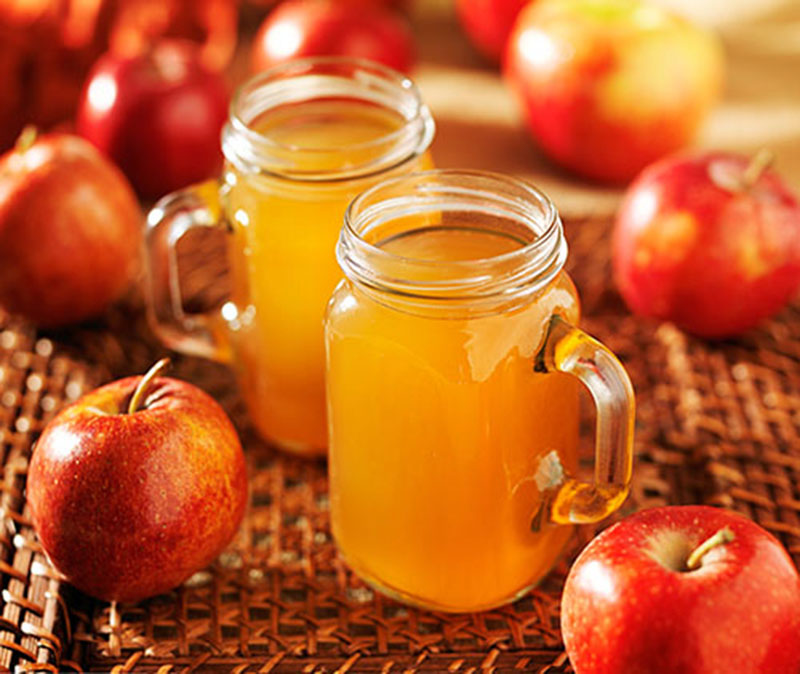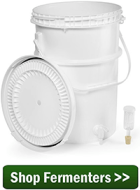 Compared to homebrewing beer, making hard cider at home is a much easier process. Since there’s no mash and no boil, it can be less labor intensive as well. Plus, you’ll be able to use the equipment you have on hand already, so why not give making hard cider a try? Read more to learn how to make hard cider at home with this 5-gallon recipe.
Compared to homebrewing beer, making hard cider at home is a much easier process. Since there’s no mash and no boil, it can be less labor intensive as well. Plus, you’ll be able to use the equipment you have on hand already, so why not give making hard cider a try? Read more to learn how to make hard cider at home with this 5-gallon recipe.
Hard cider used to be quite a popular beverage in the US. Remember Johnny Appleseed? All those apples weren’t just for apple pie! Up until prohibitionists and temperance unions started demonizing the consumption of alcohol, hard cider was about as popular as beer, if not more so. Everybody knew how to make hard cider.
Today, craft cider is riding on the heels of the craft beer movement, taking up more and more shelf space every year. Craft cideries are popping up all over the country. You’ve probably seen, and maybe even tried, ciders from Woodchuck and Crispin.
The most basic hard cider recipe requires just two main ingredients: apple juice, and yeast. There are a limitless number of variations on cider, plus some additional items that might come in handy for achieving certain characteristics. For now, let’s go over the basics of making apple cider.
Apples, Juice, or Cider?
Fall means apple season! If you’re lucky enough to live near some apple orchards, you have a fresh local ingredient in abundance right now. Ask your local apple farmer what varieties will work best for making hard cider. Cider makers often use blends of different varieties to produce a cider. Get yourself a fruit press or find some fresh, unpasteurized apple cider at your local farmers market.
Even if you don’t live near an apple orchard, chances are that your local grocery store carries soft (non-alcoholic) cider this time of year. Choose a cider that has no added flavorings or preservatives.
If you can’t find either of the above options, pure, 100% apple juice will work, too.
Yeast
Many of the yeasts used in brewing beer or making wine will work for making hard cider at home, too. Wine and champagne yeast have a higher alcohol tolerance and tend to finish dry. For a sweeter, fruitier cider, use an ale yeast, such as Nottingham. Wyeast 4766: Cider and Red Star Pasteur Blanc are both suitable for higher gravity ciders. Fermentis SafCider AB-1 yeast creates a balanced cider, you can create a crisp and aromatic drink with the AC-4 yeast, or go for a sweeter cider with the AS-2 yeast.
How To Make Hard Cider
Unless you want to take chances with a spontaneous fermentation of your hard cider, it’s important to stabilize your juice before pitching yeast.
If using filtered apple juice from the store, you will first heat the juice to stabilize it. Hold the juice at 180°F for 10-20 minutes. Let it cool, then pitch your yeast as directed on the package. Proceed as you would normally for a regular batch of homebrew, being sure to do a secondary fermentation.
If using fresh cider from the farmer’s market, use a crushed Campden tablet to stabilize the must. This will ensure that there aren’t any wild yeasts or bacteria interfering with your fermentation. Pitch your yeast as directed and proceed as above. That’s how to make hard cider. It’s really that simple.
Hard Cider Recipe (5 Gallons)
from Homebrewing for Dummies
5 gallons preservative-free apple juice
1 packet Nottingham ale yeast
2 oz. yeast nutrient 
Primary fermentation: 8 days at 70°F
Secondary fermentation: 21 days as 70°F
If desired, add priming sugar at bottling time for a sparkling cider, however if you do this make sure you bottle in beer bottles or Champagne bottles. Regular wine bottles will not hold the pressure.
Have you ever tried making hard cider before? How did it turn out? Do you have any information you’d like to share on how to make hard cider?
—–
David Ackley is a beer writer, brewer, and self-described “craft beer crusader.” He holds a General Certificate in Brewing from the Institute of Brewing and Distilling and is founder and editor of the Local Beer Blog.

I would also add some pectic enzyme so it doesn’t finish with pectic haze.
I have made two batches using apple juice and regular beer yeast; first one was of course very dry (not sweet); ok if you add some apple juice to the serving in a glass to make it more drinkable; second time I added Xyletol (non fermenting surgar; buy at a health food store) before bottling; much better since it is sweeter; just open the bottle, pour into a glass and serve; need to experiment with the Xyletol to figure out how much to use based on your tastes.
You really aren’t making hard cider with this recipe, more like apple wine with very low alcohol content. Reader needs to add sugar to raise sp.gr. to 1.080-1.090. Making hard cider then requires freezing the must and draining of the higher liquid alcohol.
I use Home grown honey 3 lbs. brown sugar 3 lbs. to 5 gals. of cider.It comes out fantastic!
Andy, when do you add the Honey and brown sugar ?
John , what you are explaining is apple jack not hard cider , cider should have about the same abv as beer or close , apple jack is freeze distilling to extract the alcohol from the water content which is ice, and….has a higher alcohol content like whiskey . Plus you’ll have ethanol which will give you a hell of a hangover X 10.
John is talking about "apple jack" and "freeze distillation", which is against federal law in the US. This article is right on for cider.
My only additional advice is
1) experiment a bunch with small batches and
2) if you want it carbonated and sweet it is WAY easier to keg it
Hi CS
Your are incorrect Freezer Distillation is not against the law.
Have a good day:)
The ATF says otherwise dude…
just a bit from ATF:
However, wine and cider may not be frozen for the express purpose of increasing the alcohol content. TTB has previously held that freezing a mixture of alcohol and aqueous fermented material, like wine, causes some water to freeze and separate from the alcohol mixture. The resultant mixture has higher alcohol content than the original and is called a “high alcohol content wine fraction” and any person who separates alcoholic spirits from any fermented substance is known as a distiller. Because Federal law requires a permit to operate as a distiller and prohibits the operation of a distillery in a residence, in order to freeze wine or cider you will have to file an application with TTB and follow our regulations regarding the manufacturing processes approved for making distilled spirits.
Ihave acess to cider but it’s UV. Treated will that hert hard cider?
Richard, the UV treatment will not affect the cider in any negative way. Yes, go ahead and use it!
hello.
can i used yeast for baking cake/bread as subtituted to Nottingham ale yeast?
and, it’s okay to not use yeast nutrient?
thank you very much
Andreas, we do not recommend using baking yeast to make wine or beer. One reason is that it does not settle out very well. You could end up with a hazy cider that your are unable to clear. Bread yeast can also produce alcohol with off flavors. We do not recommend omitting the yeast nutrient. Not using nutrient is one of the top reasons for fermentation failure.
Lack Of Nutrients
http://www.eckraus.com/wine-making-stuck-6
I like to add a pound of chopped cranberries. Brew to dryness. I finish the bottles with 1/4 tsp of honey. Cranberries can slow the ferment.
I have been making hard cider for a couple of years now. love it. I take 5 gallons from cider mill remove one gallon and dissolve one pound of sugar per gallon with 10 oz. of honey. I then pour back into carboy and plug with stopper with airlock on it. I let that go for 4 weeks and then strain with a stocking. I put back in carboy with airlock for another two weeks. Seems to work well. So my question is that what would happen if I just let it go after straining until It no longer bubbles? Will this effect the taste or stability of my cider. I just did not know what would happen if I left the airlock in there for say 8 weeks after the straining >?
Mike, the first racking should occur after 5-7 days, the second racking does occur after the fermentation completes. This is normally after about 4-5 weeks in the secondary but some may take a little longer. What you do not want to do is leave the wine on the sediment too long after the fermentation completes because it can cause off flavors. The article posted below will discuss this in more detail.
Racking Your Wine
http://www.eckraus.com/wine-making-racking
Mike, is that 10 oz of honey per gal or per 5 gal?
great recipe. the one i’ve been using is almost exactly the same, except i do not heat the juice/must, rather dump it in a bucket, add 1-2 lbs of brown sugar (my friends like it strong!) and add nottingham yeast. after 3-4 weeks it gets a 2-3 day cold crash and then into the keg with 1 or 2 cans of frozen apple juice concentrate (depending on how sweet i want it).
Seriously,
6 gallons of juice (Costco has straight juice for 8 bucks for 2 gallons), 6 lbs of sugar, 1 package Champagne yeast. Cover and airlock for 7-10 days. Rack let clear for 21-30 days. Bottle and drink. % should be between 6-11.
Just do it…:)
180F for 10-20 minutes seems unnecessarily hot and/or long. Granted, be safe if you don’t know what you’re doing definitely be safe, but I’m not gonna cook my cider longer than I cook my chicken breast, and certainly not to a higher temp. I generally go with 140F in a closed 5 gallon pot, and when I hit temp I turn it off and let it cool (still closed) to about 90F then pitch the yeast. This is a higher temp, and longer duration pasteurization than most milk undergoes. Do your own research and make your own decisions, but compare the temps here to other websites at the very least.
We have made cider from store bought preservative free juice and this year we made a fantastic fruit press to utilize our pears and apples. I have broken every rule but have turned out some good cider. We have flavored the most recent with black currant juice- delicious! We used Cotes for yeast and mixed up some simple syrup and it’s sooo good—luck purely luck. My question is- should I be adding something to prevent oxidation or not. Thank you!
Kim, you should always add sulfites to your wine before bottling or bulk aging to prevent oxidation and spoilage of the wine. It is also recommended that Ascorbic Acid be added to lighter colored wines at the beginning of fermentation. Ascorbic Acid is an anti-oxidant that helps to reduce the effects of oxidation.